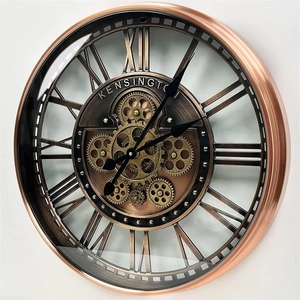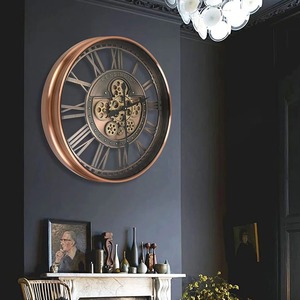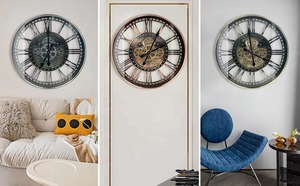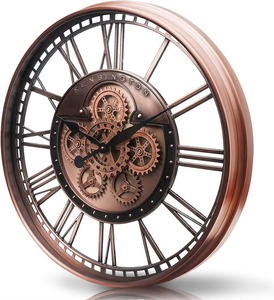
All categories
Featured selections
Trade Assurance
Buyer Central
Help Center
Get the app
Become a supplier

(87521 products available)

















































Battery clock motors are the essential mechanisms powering a wide variety of clocks. They translate the stored energy from batteries into precise timekeeping. Here's an overview of the types of battery clock motors:
Standard Quartz Movement:
Standard quartz battery movements are the most common clock motors. They utilize a quartz crystal to maintain accurate time. These movements are powered by batteries, usually AA or AAA. They are designed for wall clocks, mantel clocks, and some wristwatches. The quartz crystal vibrates at a precise frequency, driving the clock's hands with high accuracy.
Continuous Sweep Movement:
This movement is designed for clocks that need a second hand to move continuously. Unlike typical step movements, which jump every second, the continuous sweep movement offers a smooth, fluid motion. It's ideal for clocks where a tick-tock effect isn't desirable, such as in certain scientific or high-end decorative clocks.
Stepper Motor Movement:
Stepper motor movements are used in clocks requiring more power or torque. This motor type moves in discrete steps, allowing for precise control over the clock's hands. These movements are often used in larger clocks or those with more significant, heavier hands. They are also used in digital clocks for display control.
Chime Movement:
Chime movements power clocks that produce musical chimes or tones at specific times. These movements often have complex gears and hammers to strike bells or produce chime sounds. They are commonly used in grandfather clocks, wall clocks, and mantle clocks, adding a musical element to timekeeping.
Westminter Chime Movement:
Westminster chime movements are a subset of chime movements. They play the famous Westminster tune. These movements are used in various clocks, especially wall and mantel clocks. They use a set of hammers to strike corresponding chime rods or tubes.
Quartz Pendulum Movement:
Pendulum clock movements incorporate a pendulum in the design. These movements have a mechanism to swing the pendulum back and forth. They are used in decorative clocks that mimic old-fashioned pendulum clocks' style and look.
Clock Radio Movement:
Clock radio movements combine a clock mechanism with a radio. These movements have additional components to receive radio signals and display them on the clock. They are commonly used in alarm clocks, providing time and radio entertainment.
Timer Movement:
Timer clock movements are used in kitchen timers and other countdown applications. These movements have a mechanism to count down and signal when time is up. They are common in cooking appliances, helping to keep track of cooking times.
Multi-Function Movement:
Multi-function clock movements combine multiple features into one mechanism. They can display time, date, temperature, and humidity using different hands and dials. These movements are used in various clocks, especially those where users want to access multiple information at once.
Gear train design
The gear train is the clock motor component that controls the speed of the motor. It consists of multiple gears of different sizes that work together to reduce the speed of the motor and increase the torque. The gear train is designed so that a small change in the rotation of the motor results in a large change in the rotation of the clock hands.
Case design
The case of a battery clock motor is designed to protect the internal components from dust, moisture, and damage. It is usually made from durable materials such as plastic or metal. The case design also includes features such as mounting brackets or clips to make it easy to install the motor in a clock.
Mounting design
Clock motors have a mounting design that ensures they can be easily fitted into various clock types. They have a shaft that extends from the back of the motor for hand attachment. This shaft usually fits into a pre-drilled hole in the clock face. The mounting design also includes features such as mounting brackets or clips to make it easy to install the motor in a clock.
Power supply design
The power supply design of a battery clock motor includes components that regulate the voltage and current supplied to the motor. This is important for maintaining the battery's life and ensuring the motor operates efficiently. Some modern clock motors come with rechargeable batteries, which require power supply designs like the charging circuit that allow them to be charged when connected to an external power source.
Control circuit design
The control circuit design of a battery clock motor includes components that regulate the motor's operation. This is important for ensuring the motor runs smoothly and efficiently. In some modern clock motors, control circuit designs are implemented in the form of microcontrollers or programmable logic devices, which allow for more precise and flexible control of the motor's operation.
Battery clock motors are versatile components that can be used in various scenarios across different industries. Some of these scenarios include:
Wall Clocks:
Wall clocks are one of the most common applications for battery clock motors. These clocks are widely used in homes, offices, schools, and public spaces to keep track of time. Wall clock motors power the hands to provide a simple yet effective way to display time.
Table Clocks:
Table clocks, also known as desk clocks or mantel clocks, are smaller timepieces designed to sit on a flat surface. Battery clock motors drive the hands of these decorative and functional clocks, which are often used in living rooms, bedrooms, and offices.
Grandfather Clocks:
Modern grandfather clocks often incorporate battery-powered clock motors for convenience and ease of maintenance. These longcase clocks can still feature traditional pendulums and weights but benefit from the accuracy and low-maintenance requirements of battery motors.
Outdoor Clocks:
Outdoor clocks are designed to withstand the elements, and battery clock motors power them just like any other clock. These clocks can be found in gardens, parks, or on building exteriors. The battery motor eliminates the need for cumbersome wiring, making installation straightforward.
Event Countdown Clocks:
Countdown clocks are used to display the remaining time for events such as sports competitions, exams, or timers cooking. Battery clock motors are used to run these clocks. They are designed for easy visibility and often feature large, bright displays.
Decorative and Novelty Clocks:
There are many decorative and novelty clocks, each with unique designs. From flip clock motors to digital alarm clocks, each clock has a unique appearance and design. Decorative and novelty clocks use battery clock motors, which are powered by batteries. These clocks add personality to any space while serving as a timekeeping device.
Event Count-up Clocks:
Event count-up clocks are used to display the elapsed time since the beginning of an event. These clocks can be used in various scenarios, such as tracking the duration of a meeting, recording times in sports, or displaying uptime in systems. Battery clock motors are used to run these clocks. They are intuitive and easy to read, often featuring large, bold displays for maximum visibility.
Purpose and Type of Clock:
When choosing a battery clock motor, consider the clock's purpose and type. Different clocks have different needs. A decorative wall clock may need a motor that drives long hand shafts to show stylish hands. A tiny alarm clock needs a precise motor that keeps time well. A large floor clock may need a high-torque motor to move heavy hands.
Power Source:
Next, think about the power source for the clock. Battery-operated clock motors are convenient since they don't require wiring. They are suitable for any place. It is essential to choose the right battery motor that matches the battery size the clock will use. These motors come with battery holders for AA, AAA, C, and other batteries. Select one that fits your battery.
Torque and Shaft Length:
The motor's torque must match the clock's weight. If it is too low, it won't move the hands correctly. The shaft length must fit the clock's thickness. The clock motor should have a torque rating that matches the weight of its hands. It should have a shaft long enough to attach the clock's dial.
Features and Functions:
Consider any extra features the clock may need. Some motors have sweeping second hands that move smoothly instead of ticking. Some motors keep accurate time over long periods. Some decorative motors even add chime features for hourly sounds.
Quality and Reliability:
Choose a reliable motor from a good maker. Quality motors last longer and keep better time. Check for warranties or guarantees that assure performance, too.
Environmental Considerations:
Think about the environment when choosing a motor. Some clocks work better with low-power motors. Select those that use less energy. It is also a suitable choice for solar-powered clocks, which are better for nature.
Cost and Budget:
Finally, consider the cost. Basic clock motors are inexpensive. But if a motor has special features, it may cost more. Choose one that fits the budget while providing needed performance.
Q1: How are battery clock motors rated?
A1: Battery clock motors are rated based on their torque, which is the strength of the motor measured by its ability to turn a shaft. This rating is given in inch-ounces, and the motor is selected according to the weight of the clock hands. For example, a small second hand requires a low torque rating, while heavy hands for wall clocks need a high torque motor. Motors are also rated by the type of power they use, which can be batteries, electricity or solar power.
Q2: What are the common sizes of battery clock motors?
A2: Battery clock motors are available in different sizes to fit various clock designs. The common sizes include mini, small, medium, large, and high torque. Depending on what the clock will be used for, one can choose from these sizes. For instance, a wall clock that is more visible will require a large size compared to a table or desk clock that will be less visible and need a smaller size.
Q3: Are battery clock motors easy to replace?
A3: Yes, replacing a battery clock motor is a simple process that can be done without professional help. To replace it, one has to take out the old one and put in a new one by securing the clock hands and replacing the backing. This makes replacing a battery clock motor easy and inexpensive if it breaks or loses efficiency.
Q4: How can the lifespan of a battery clock motor be extended?
A4: The lifespan of a battery clock motor can be extended by taking care of some things. Using good quality batteries and replacing them as soon as they run out can help keep the motor working well. Keeping the clock in a place with steady temperatures and no extreme heat or cold can also help the motor last longer. Avoiding heavy or fast-moving clock hands reduces the strain on the motor, which can keep it working longer.
Q5: Are battery clock motors waterproof?
A5: Battery clock motors are not usually waterproof. Keeping clocks with these motors away from water or wet areas is essential to avoid damaging the motor and clock. Some battery clock motors may have water-resistant features designed for specific applications. It is still essential to confirm with the supplier before purchasing.